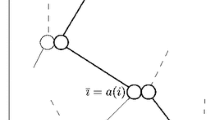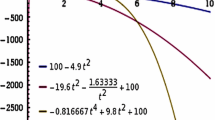Abstract
This paper is dedicated to the description of kinematic dynamo action in a sphere and its analytical treatment with the Bullard–Gellman formalism. One goal of dynamo theory is to answer the question: Can magnetic fields of stellar objects be generated or sustained due to (fluid) motion in the interior? Bullard and Gellman were among the first to study this question, leading the way for many subsequent studies, cf. Bullard (Philos Trans R Soc A 247(928):213–278, 1954). In their publication the differential equations resulting from a toroidal–poloidal decomposition of the velocity and magnetic field are stated without an in-depth discussion of the employed methods and computation steps. This study derives the necessary formalism in a compact and concise manner by using an operator-based approach. The focus lies on the mathematical steps and necessary properties of the considered formalism. Prior to that a derivation of the induction equation is presented based on rational continuum electrodynamics. As an example of the formalism the decay of two magnetic fields is analyzed.
Similar content being viewed by others
Abbreviations
- c :
-
Speed of light in vacuum
- \(\mathcal {B}_R\) :
-
Spherical material body of radius R
- \(\varvec{v}\) :
-
Velocity
- \(\varvec{n}\) :
-
Surface unit normal vector
- \(\varvec{e}\) :
-
Unit normal vector of a singular surface or material interface
- \(w_\perp \) :
-
Normal component of the velocity of a singular surface or material interface
- \(\,\mathrm {d}A\) :
-
Area element
- \(\,\mathrm {d}\varOmega \) :
-
\(r^{-2}\,\mathrm {d}A\). Normalized area element
- \(\,\mathrm {d}V\) :
-
Volume element
- \(\mathcal {O}(\bullet )\) :
-
Order of magnitude of the considered field
- \(\mathbf {A}\) :
-
Dimension matrix
- \(\mathbf {k}_i\) :
-
Null space vectors of \(\mathbf {A}\)
- \(\mathrm {\Pi }_i\) :
-
Dimensionless products
- \( Re _\text {mag.}\) :
-
Magnetic Reynolds number
- \(\lambda \) :
-
Eigenvalue of the induction equation
- \(\varvec{B}\) :
-
Magnetic flux density
- \(\varvec{E}\) :
-
Electric field
- \(\varvec{H}\) :
-
Total current potential
- \(\varvec{\mathfrak {H}}\) :
-
Free current potential
- \(\varvec{M}\) :
-
Magnetization or bond current potential
- \(\varvec{D}\) :
-
Total current potential
- \(\varvec{\mathfrak {D}}\) :
-
Free current potential
- \(\varvec{P}\) :
-
Magnetization or bond charge potential
- q, \(q^{\text {f}}\), \(q^{\text {r}}\) :
-
Total, free and bond charge density
- \(\varvec{J}\), \(\varvec{J}^{\text {f}}\), \(\varvec{J}^{\text {r}}\) :
-
Total, free and bond current density
- \(V_\mathrm {m}\) :
-
Magnetic scalar potential
- \(\sigma \) :
-
Electric conductivity
- \(\varepsilon _0\), \(\mu _0\) :
-
Vacuum permittivity and permeability
- \(Y^m_n\) :
-
Complex-valued spherical harmonics
- \(C^m_n\) :
-
Real-valued cosine spherical harmonics
- \(S^m_n\) :
-
Real-valued sine spherical harmonics
- \(P^m_n\) :
-
Associated Legendre polynomials
- \(J_n\) :
-
Bessel functions of 1\(\mathrm {st}\) kind
- \(\nabla _S\) :
-
\((\varvec{1}-\varvec{n}\otimes \varvec{n})\cdot \nabla \) Surface del-operator
- \(\nabla _{\theta ,\varphi }\) :
-
\(r\nabla _S=\varvec{e}_\theta \frac{\partial }{\partial \theta }+\varvec{e}_\varphi \frac{1}{\sin (\theta )}\frac{\partial }{\partial \varphi }\). Angular part of the spherical surface del-operator
- \(\Delta _S\) :
-
\(\nabla _S\cdot \nabla _S\). Surface Laplace-operator
- \(\Delta _{\theta ,\varphi }\) :
-
\(r^2\Delta _S=\frac{1}{\sin (\theta )}\frac{\partial }{\partial \theta }\big (\sin (\theta )\frac{\partial }{\partial \theta }\big )+\frac{1}{\sin ^2(\theta )}\frac{\partial ^2 }{\partial \varphi ^2}\). Angular part of the spherical surface Laplace-operator
- \(\varvec{\mathcal {D}}_{\theta ,\varphi }\) :
-
\(\varvec{e}_\theta \frac{1}{\sin (\theta )}\frac{\partial }{\partial \varphi }-\varvec{e}_\varphi \frac{\partial }{\partial \theta }\). Differential operator related to toroidal vector fields
- \( \mathcal {D}_{\theta ,\varphi }[f,g] \) :
-
\(\nabla _{\theta ,\varphi }f\cdot \varvec{\mathcal {D}}_{\theta ,\varphi }[g] \). Bilinear antisymmetric differential operator
- \(D_{r}^{1}{[}{f}{]}\) :
-
\(\frac{1}{r}\frac{\mathrm{d}}{\mathrm{d}r}(r f(r))\)
- \(\varvec{T}^{i}_{j}\) :
-
Complex-valued toroidal vector fields
- \(\varvec{P}^{i}_{j}\) :
-
Complex-valued poloidal vector fields
- \(t^i_j(r)\) :
-
Radial functions of \(\varvec{T}^{i}_{j}\)
- \(p^i_j(r)\) :
-
Radial functions of \(\varvec{P}^{i}_{j}\)
- \(\varvec{U}^{k}_{l}\) :
-
Complex-valued toroidal velocity fields
- \(\varvec{Q}^{k}_{l}\) :
-
Complex-valued poloidal velocity fields
- \(u^k_l(r)\) :
-
Radial functions of \(\varvec{U}^{k}_{l}\)
- \(q^k_l(r)\) :
-
Radial functions of \(\varvec{Q}^{k}_{l}\)
- \(\varvec{\mathcal {T}}^{m}_{n}\) :
-
Complex-valued toroidal projectors
- \(\varvec{\mathcal {P}}^{m}_{n}\) :
-
Complex-valued poloidal projectors
- \(\tilde{\varvec{T}}\phantom {\varvec{T}}^{i}_{j}\) :
-
Complex-valued toroidal vector fields
- \(\tilde{\varvec{P}}\phantom {\varvec{P}}^{i}_{j}\) :
-
Complex-valued poloidal vector fields
- \(\tilde{t}^i_j(r)\) :
-
Radial functions of \(\tilde{\varvec{T}}\phantom {\varvec{T}}^{i}_{j}\)
- \(\tilde{p}^i_j(r)\) :
-
Radial functions of \(\tilde{\varvec{P}}\phantom {\varvec{P}}^{i}_{j}\)
- \(\tilde{\varvec{U}}\phantom {\varvec{U}}^{k}_{l}\) :
-
Complex-valued toroidal velocity fields
- \(\tilde{\varvec{Q}}\phantom {\varvec{Q}}^{k}_{l}\) :
-
Complex-valued poloidal velocity fields
- \(\tilde{\varvec{\mathcal {T}}}\phantom {\varvec{\mathcal {T}}}^{m}_{n}\) :
-
Complex-valued toroidal projectors
- \(\tilde{\varvec{\mathcal {P}}}\phantom {\varvec{\mathcal {P}}}^{m}_{n}\) :
-
Complex-valued poloidal projectors
- \(K^{ikm}_{jln}\) :
-
Adams–Gaunt integral
- \(L^{ikm}_{jln}\) :
-
Elsasser integral
- w(i, j, k):
-
\(i(i+1)+j(j+1)-k(k+1)\)
- ODE:
-
Ordinary differential equation
- PDE:
-
Partial differential equation
- ref.:
-
Reference scale
References
Abramowitz, M., Stegun, I.A.: Handbook of Mathematical Functions. Applied Mathematics Series, vol. 55, 10th edn. National Bureau of Standards (1972). http://people.math.sfu.ca/~cbm/aands/
Arfken, G.B., Weber, H.J.: Mathematical Methods for Physicists, 6th edn. Elsevier Academic Press, Amsterdam (2005)
Bronstein, I.N., Semendjajew, K.A., Musiol, G., Mühlig, H.: Handbook of Mathematics, 6th edn. Springer, Berlin (2015)
Bullard, E., Gellman, H.: Homogeneous dynamos and terrestrial magnetism. Philos. Trans. R. Soc. A 247(928), 213–278 (1954)
Collatz, L.: Eigenwertaufgaben mit technischen Anwendungen, 2nd edn. Akademische Verlagsgesellschaft, Leipzig (1963)
Dudley, M.L., James, R.W.: Time-dependent kinematic dynamos with stationary flows. Philos. Trans. R. Soc. Lond. Ser. A Math. Phys. Sci. 425, 407–429 (1989)
Dziubek, A.: Equations for two-phase flows: a primer. Meccanica 47(8), 1819–1836 (2012). https://doi.org/10.1007/s11012-012-9555-0
Elsasser, W.M.: On the origin of the earth’s magnetic field. Phys. Rev. 55, 489–498 (1939). https://doi.org/10.1103/PhysRev.55.489
Elsasser, W.M.: Induction effects in terrestrial magnetism part I: theory. Phys. Rev. 69(3–4), 106 (1946a). https://doi.org/10.1103/PhysRev.69.106
Elsasser, W.M.: Induction effects in terrestrial magnetism part II: the secular variation. Phys. Rev. 70(3–4), 202 (1946b)
Elsasser, W.M.: Induction effects in terrestrial magnetism: part III. Electric modes. Phys. Rev. 72(9), 821 (1947)
Eringen, A.C., Maugin, G.A.: Electrodynamics of Continua I, 1st edn. Springer, Berlin (1990). https://doi.org/10.1007/978-1-4612-3226-1
Gauß, C.F.: Allgemeine Theorie des Erdmagnetismus. In: Werke, Fünfter Band, Mathematische Physik, vol. 5. Dieterich, pp. 121–193 (1838)
Glatzmaier, G.A., Roberts, P.H.: A three-dimensional self-consistent computer simulation of a geomagnetic field reversal. Nature 377, 203–208 (1995). https://doi.org/10.1038/377203a0
Gubbins, D.: Numerical solutions of the kinematic dynamo problem. Philos. Trans. R. Soc. A 274(1241), 493–521 (1973). https://doi.org/10.1098/rsta.1973.0074
Gubbins, D., Barber, C.N., Gibbons, S., Love, J.J.: Kinematic dynamo action in a sphere. I. Effects of differential rotation and meridional circulation on solutions with axial dipole symmetry. Proc. R. Soc. Lond. Ser. A Math. Phys. Eng. Sci. 456(1998), 1333–1353 (2000a)
Hansen, W.W.: A new type of expansion in radiation problems. Phys. Rev. 47, 139–143 (1935). https://doi.org/10.1103/PhysRev.47.139
Hutter, K., Jöhnk, K.: Continuum Methods of Physical Modeling. Springer, Berlin (2004). https://doi.org/10.1007/978-3-662-06402-3
Hutter, K., van de Ven, A.A.F., Ursescu, A.: Electromagnetic Field Matter Interactions in Thermoelastic Solids and Viscous Fluids. Lecture Notes in Physics, vol. 710. Springer, Berlin (2006)
Itskov, M.: Tensor Algebra and Tensor Analysis for Engineers. Springer, Berlin (2009). https://doi.org/10.1007/978-3-540-93907-8
Jackson, J.D.: Classical Electrodynamics, 3rd edn. Wiley, New York (1998)
Kovetz, A.: Electromagnetic Theory. Oxford University Press, Oxford (2000)
Kumar, S., Roberts, P.H.: A three-dimensional kinematic dynamo. Proc. R. Soc. Lond. A Math. Phys. Eng. Sci. 344(1637), 235–258 (1975). https://doi.org/10.1098/rspa.1975.0100
Larmor, J.: How could a rotating body such as the sun become a magnet? Report of the British Association for the Advancement of Science 87th Meeting, pp. 159–160 (1919)
Merrill, M.W., McElhinny, M.W., McFadden, P.L.: The Magnetic Field of the Earth: Paleomagnetism, the Core, and the Deep Mantle, vol. 63, 1st edn. Academic Press, Boca Raton (1998)
Müller, I.: Thermodynamics, 1st edn. Pitman Publishing, Boston (1985)
Müller, W.H.: An expedition to continuum theory. In: Gladwell, G.M.L. (ed.) Solid Mechanics and its Applications, vol. 210. Springer, Berlin (2014). https://doi.org/10.1007/978-94-007-7799-6
Roberts, P.H.: Kinematic dynamo models. Philos. Trans. R. Soc. A 272(1230), 663–698 (1972). https://doi.org/10.1098/rsta.1972.0074
Roberts, P.H.: Theory of the geodynamo (chap. 3). In: Schubert, G., Olson, P. (eds.) Core Dynamics: Treatise on Geophysics, vol. 8, pp. 67–105. Elsevier, Amsterdam (2009)
Simpson, J., Weiner, E. (eds.): The Oxford English dictionary, 2nd edn. Oxford University Press, Oxford (1989)
Slattery, J.C., Sagis, L., Oh, E.S.: Interfacial Transport Phenomena, 2nd edn. Springer, Berlin (2007)
Stratton, J.A.: Electromagnetic Theory. The IEEE Press Series on Electromagnetic Wave Theory. McGraw-Hill, New York (1941)
Winch, D., James, R.: Computations with spherical harmonics and Fourier series in geomagnetism. In: Bolt, B.A. (ed.) Geophysics: Methods in Computational Physics: Advances in Research and Applications, vol. 13, pp. 93–132. Elsevier, Amsterdam (1973). https://doi.org/10.1016/B978-0-12-460813-9.50009-6
Wolfram Research, Inc.: Mathematica (Version 10.1). Champaign, Illinois (2015)
Author information
Authors and Affiliations
Corresponding author
Additional information
Communicated by Andreas Öchsner.
Rights and permissions
About this article
Cite this article
Glane, S., Reich, F.A. & Müller, W.H. The kinematic dynamo problem, part I: analytical treatment with the Bullard–Gellman formalism. Continuum Mech. Thermodyn. 30, 731–774 (2018). https://doi.org/10.1007/s00161-018-0638-6
Received:
Accepted:
Published:
Issue Date:
DOI: https://doi.org/10.1007/s00161-018-0638-6




